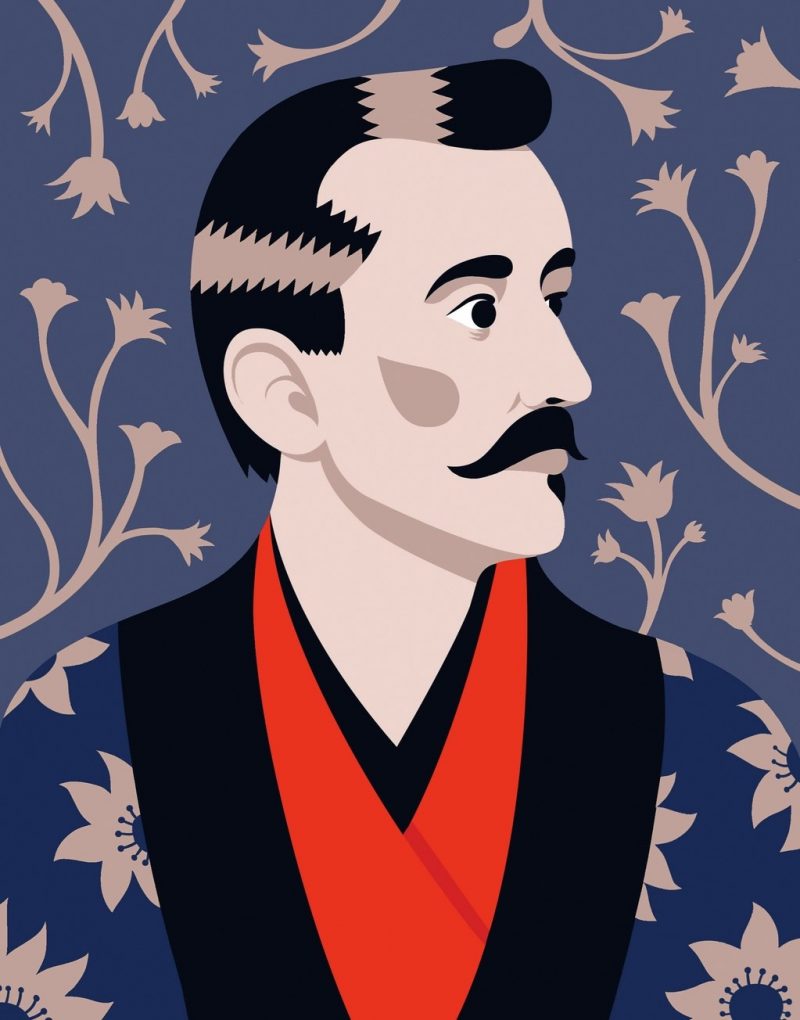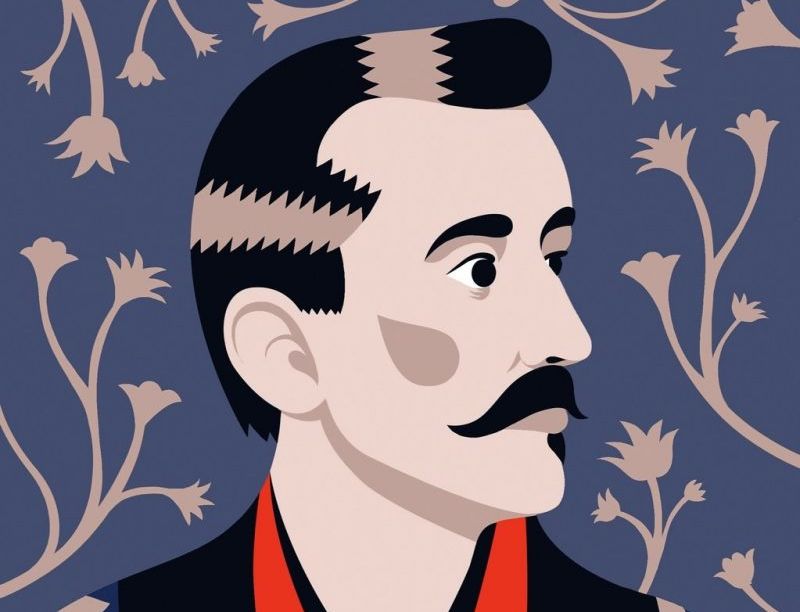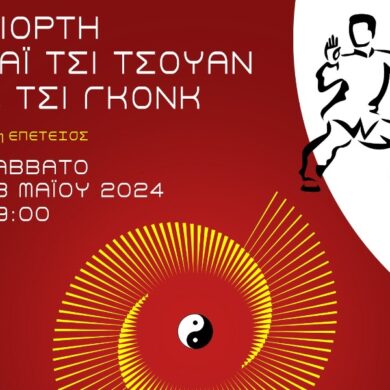The author’s rendering of Japanese folktales made him famous around the globe, but, a century later, Hearn remains the wildest character of all.
By Jonathan Dee
In his fifty-four years among the living, Patrick Lafcadio Hearn wrote twenty-nine books in just about every conceivable genre—folktales, travelogues, novels, cookbooks, translations, dictionaries of proverbs—none of which can compete, in terms of sheer Dickensian horror and pluck, with the story of his own life. He was born in 1850 on the Greek island of Lefkáda (one of the Ionian Islands, at the time still under British control), to an Ionian mother named Rosa and an Irish father, Charles, who was stationed there as a staff surgeon in the British Army. Their youthful romance reputedly grew into love when she nursed him back to health after he was set upon and stabbed multiple times by her brother, who viewed their liaison as a stain on the family’s honor. They married and, with their two-year-old son, relocated to Dublin to move in with Charles’s family, some of whom considered their honor pretty well stained, too. On a leave between overseas postings, Charles took up with an old girlfriend, around which time Rosa—pregnant again, speaking little English, exhibiting symptoms of mental illness—bolted back to the islands, leaving behind her son, who was then four years old. Mother and child never saw each other again; she spent her last years confined to an asylum in Corfu. Charles had the marriage annulled, then quickly remarried and moved to India. The boy, now seven, never saw his father again, either.
An ignominious and unexpected burden to his family, Paddy, as he was then known, was reared in the prosperous Dublin home of his great-aunt Sarah. “His mind,” in the words of one of his biographers, was “dominated by horror from an early age.” He had a crippling fear of the dark, which was treated by putting him to bed every night in a pitch-dark room that was locked from the outside. At age thirteen, he was sent to a Roman Catholic boarding school in England, where a playground incident caused a grievous injury to his left eye. As lasting as the resulting blindness in that eye was Hearn’s terrible self-consciousness about his disfigured appearance. He was freed from the misery of that boarding school only when Sarah, having been bilked by a fortune hunter, went broke and had to withdraw him. For the next two years, he lived in an East London slum with one of Sarah’s former maids.
It gets wilder. Hearn—who was considered, by the European standards of the day, to be of mixed race—was nineteen when a relative of his father’s, acting out of some combination of concern and embarrassment, gave him a one-way boat ticket to New York and the address of a distant relation in Cincinnati. Somehow, Hearn reached this stranger’s door, where he was handed a few dollars and was told to fend for himself. And here the story of Paddy Hearn, the baroquely unwanted homeless youth, starts to flower into the biography of Lafcadio Hearn, the writer whose reputation would eventually reach across the world. After starting out as a printer’s assistant, he lucked into an emergency assignment covering a lurid local murder, and he did such a bang-up job that his story was republished in papers across the country. He parlayed this into a regular gig as a sort of Weegee of words, covering the city’s most violent and squalid stories for the Cincinnati Enquirer, under the byline “Dismal Man.”
He lost that job when his employers learned that he had secretly married a biracial woman, Alethea Foley, who had been born into slavery—a marriage illegal in Ohio at the time. In 1877, he moved, without his wife, to the more hospitable environment of New Orleans. He continued writing, in more respectable veins (editorials, short fiction, translations from the French), and he took a particular interest in Creole cuisine, writing a book about it and opening a restaurant in which everything on the menu cost five cents. As his authority and reputation grew, his writing took on a certain quality of cultural ownership: never having had a real home, he compulsively, and rather lovingly, documented the domestic customs of wherever he was living at the time. In New Orleans, in addition to his culinary research, he wrote sketches about such topics as “The Creole Character.” A two-year stay in Martinique resulted, a year later, in “Two Years in the French West Indies,” a travelogue-cum-cultural-history that, tragically, became definitive when, twelve years later, Saint-Pierre, the city where he had lived and written, was destroyed by a volcanic eruption. He was building a home for himself, a permanence, out of words; without a culture of his own, he was desperate to attach himself to others’.
At age thirty-nine, Hearn travelled on a magazine assignment to Japan, and never came back. At a moment when that country, under Emperor Meiji, was weathering the shock and upheaval of forced economic modernization, Hearn fell deeply in love with the nation’s past. He wrote fourteen books on all manner of Japanese subjects but was especially infatuated with the customs and culture preserved in Japanese folktales—particularly the ghost-story genre known as kaidan. He married into a samurai family and eventually, in order to become a Japanese citizen, was adopted by the family and took its name, becoming known thereafter as Koizumi Yakumo. (One of the consequences of his new citizenship was that the University of Tokyo, where he lectured, reduced his salary, in line with its policy of paying nationals less than it paid foreigners.) He died in 1904, and, by the time his “Japanese tales” were translated into Japanese, in the nineteen-twenties, the country’s transformation was so complete that Hearn was hailed as a kind of guardian of tradition; his kaidan collections are still part of the curriculum in many Japanese schools.
One hesitates to say that Hearn is now being “rediscovered” by an English-language readership, because his output was so voluminous and so varied that some corner of it seems to resurface every decade or so. His haiku and tanka translations influenced Pound, Rexroth, and others. His “La Cuisine Creole”—the first cookbook of its kind—is historically invaluable. There are Hearn museums virtually everywhere he lived in Japan, and in 2015 the Lafcadio Hearn Japanese Gardens were dedicated, in the seaside town of Tramore, Ireland, near the spot where young Hearn said goodbye to his father for the last time.
But this season there is a rare confluence of books by or about him: Penguin Classics has put together a Hearn collection called “Japanese Ghost Stories”; Princeton University Press has just issued a similar compendium called “Japanese Tales of Lafcadio Hearn,” with a passionate introduction by Andrei Codrescu; and the latest work from the esteemed Vietnamese-American novelist Monique Truong, “The Sweetest Fruits” (Viking), is a fictional reconstruction of Hearn’s picaresque life told in the voices of the three women—his two wives and his mother—whose time with him proved most formative.
What we make of Hearn now depends on how we frame him in the volatility of our own historical moment. Close one eye and he is a unique tragic hero, a victim and an outcast, who consistently championed nondominant cultures and tried to bind his own deep psychological wounds by celebrating in prose the world beyond the white, European society that had tortured and rejected him. Close the other eye and he is just another nineteenth-century white man who appointed himself an expert on places and cultures in which he was a tourist, making a career out of depicting or interpreting these cultures as if they were his to represent or to profit from. The very premise of Truong’s novel makes a salient contemporary point: Hearn’s global search for love and acceptance may have been touching, but even the search was a privilege. The women in his wake—none of them white—suffered gravely as well, and they didn’t have the option of lighting out for the territories.
In his earliest Dismal Man writing, Hearn was rewarded for going intensely purple (a crime scene contains “masses of crumbling human bones, strung together by half-burnt sinews, or glued one upon another by a hideous adhesion of half-molten flesh, boiled brains and jellied blood mingled with coal”), and that quality lingered in his prose for years. But with the domestic, material simplicity he embraced in Japan came a fulfillment of his long-expressed desire to find a voice that spoke more plainly, yet with no less mystery or effect. It’s hard to improve on the opening sentence of “The Corpse-Rider,” for example: “The body was cold as ice; the heart had long ceased to beat; yet there were no other signs of death.”
Some of the kaidan are scary (one ends with the sentence “The child’s head had been torn off!”), but for the most part that’s not their aim: they are Buddhism-inflected folktales about interactions between the living and the dead, featuring a complex interplay of fear and desire, disgust and wish fulfillment. In “Of Ghosts and Goblins,” the opening tale in the Penguin collection, a young man is conscripted into a distant war, and the woman to whom he has been betrothed “from infancy” dies before he can return to marry her. He sets out to kill himself on her grave, but such is the power of his love and grief that she appears before him, lays her hand upon his, and says, “I am not dead. It was all a mistake. . . . I have seen your heart, and that was worth all the waiting, and the pain . . . But now let us go away at once to another city, so that people may not know this thing and trouble us; for all still believe me dead.” In their new home, they open “a little food-shop” and raise a son; domestic bliss blinds the man to the fact that the woman has indeed been dead the whole time. When her parents stumble upon the shop, his wife vanishes again, this time for good.
Our primal fear when it comes to ghosts, Hearn wrote, is not of seeing or hearing them but of being touched by them; the kaidan both exploit that revulsion and offer the heroic spectacle of characters whose passions enable them to overcome it. A mother dies during a cholera epidemic, yet her love for her infant son is so powerful that she continues to nurse him for three years after her death—an outcome, as in many of the tales, somehow both sentimental and horrifying. “Of a Promise Broken” relates the story of a widower who reneges on a deathbed vow made to his beloved wife: never to marry again. The new bride, just seventeen, is menaced and eventually beheaded by the ghost of the old one, a conclusion followed by this coda, in which the “I” is Hearn himself:
“That is a wicked story,” I said to the friend who had related it. “The vengeance of the dead—if taken at all—should have been taken upon the man.”
“Men think so,” he made answer. “But that is not the way that a woman feels. . . .”
He was right.
What makes these stories, preserved from ancient times, especially readable today is the preternaturally postmodern form they are given in Hearn’s deeply idiosyncratic telling. He inserts himself into them in the most casually disruptive ways: offering interpretations or digressive asides about the person who first told him the tale in question, or saying that there is more to the story but he has forgotten it. He interrupts one tale to complain, Charles Kinbote-like, about the ubiquitous sight of telegraph poles in the hotel where he was staying when he first heard the story he is relating. Elsewhere, he lets us know that he is drawing from someone else’s book (an Englishman’s “Japanese Fairy-Tale Series”)—relaying the story “in my own words,” Hearn assures us, but with the book open beside him as he writes. At the end of “The Corpse-Rider,” he complains that he does not find its conclusion “morally satisfying.” Metafiction goes back hundreds of years before Hearn, but meta-folk feels like an offshoot that one has not previously encountered. As so often with Hearn, there are two ways to feel about this. Unquestionably, it makes for a more interesting and sophisticated reading experience, and yet these authorial intrusions in ancient narratives represent a kind of claim to them, a display of control.
And here we touch on the interesting question of how he was exposed to many of these ghost stories in the first place. His second wife, Setsu, knowing his love for folk literature in general and ghost stories in particular, scoured secondhand bookstores for such stories, read them, committed them to memory, and then recited them in English to Hearn in their bedroom, late at night, “having lowered the wick of the lamp on purpose,” as she put it. Listening to her, he became so childishly terrified that his reaction sometimes scared Setsu, who would worry that she had gone too far. Then he would take notes.
What drew Hearn so powerfully to these stories about the return of the departed? It’s fair to situate him within the Victorian gothic-horror movement (his life and work were contemporaneous with Bram Stoker’s), and his unhappy Irish boyhood coincided with the folklore-prizing Irish literary revival beginning in the latter part of the nineteenth century (the subject of an interesting late-in-life correspondence with Yeats). The embrace of folk-based supernatural principles also fit nicely with the revulsion Hearn felt toward institutional religion, having experienced the hypocritical pieties of his great-aunt’s household and the cruelties of his Roman Catholic boarding school.
But a more personal explanation suggests itself as one notices the shared premise of tale after tale: nearly every one of them is about a young woman who disappears. Sometimes she is wronged and stranded in the invisible world; sometimes she performs miracles in order to be reunited with a loved one she left behind. The possibility that the dead, whose absences are so painful and hard to understand, are still among us, and may still want something from us: this is the seat of horror, but also of fantasy.

Illustration by Agostino Iacurci. The author’s stories can’t compete, in sheer horror, with the drama of his own life.
It seems impossible that Hearn was unaware of the personal echoes in a tale like “Before the Supreme Court,” in which a young girl named Kinumé emerges from three days of unconsciousness in a state of utter alienation: “She rose from the bed, looked wildly about the room, and rushed out of the house, exclaiming:—‘This is not my home!—you are not my parents!’ ” In the middle of a tale called “The Eternal Haunter,” in which a man has a relationship with a tree spirit, Hearn stops to apostrophize:
Perhaps—for it happens to some of us—you may have seen this haunter, in dreams of the night, even during childhood. Then, of course, you could not know the beautiful shape bending above your rest: possibly you thought her to be an angel. . . . Once that you have seen her she will never cease to visit you. And this haunting,—ineffably sweet, inexplicably sad,—may fill you with rash desire to wander over the world in search of somebody like her. But however long and far you wander, never will you find that somebody.
Though he seems to have been a loving husband toward Setsu (and a doting father to their four children), Hearn’s personal relationships were, for the most part, marked by a kind of skittishness and extreme sensitivity; if he felt slighted or unwanted, he would break off a friendship or a romance immediately, without explanation. His first biographer (and longtime friend), Elizabeth Bisland, writing in 1906, dated to Hearn’s childhood “his strange distrusts, his unconquerable terror of the potentialities which he suspected as lurking beneath the frankest exterior, and his constant, morbid dread of betrayal and abandonment by even his closest friends.”
Who can blame him? He waited all his life, if only in dreams, for the return of the one who abandoned him, who existed on the other side of some uncanny perceptual curtain. There is a sameness to the ghost stories, and it becomes poignant to the degree that one accepts these traditional Japanese tales, in this hybrid telling and package, as an oblique form of auto-therapy, scaring their teller along with his audience and then resolving that fear in one stroke, at least until the next night, when it will have to be done all over again. There is something narcissistic about this project—something self-absorbed, in a way that only the emotionally wounded can be. Two thousand years of Buddhist folk tradition were drawn into the service of one European man’s psychodrama. (If Hearn’s whiteness was doubtful in Europe, it was certainly not in Japan.) So, too, were the real lives of others. Truong’s novel not only tells their story but does so in their voices; “The Sweetest Fruits” takes the somewhat stagy form of three long monologues, delivered to silent interviewers.
The dilemma faced by “The Sweetest Fruits” is that it is explicitly a kind of historical salvage operation, an act of reclamation and redemption; and what would be the purpose of redeeming the long-silent voices of these women only to make them critique or compromise themselves? It’s a generous impulse, yet it makes for a somewhat uniform, hagiographical tone, which favors dignity over complexity. The real-life Rosa, for instance, is a fascinating character—mistreated, disoriented, beset by demons from within and without—and the challenge of inhabiting her empathetically enough to make us sympathize with her Medea-like decision to abandon her four-year-old son would normally be catnip to any fiction writer as good and as serious as Truong. But the fifty-odd pages of the novel narrated in Rosa’s voice, ostensibly while on her voyage from Dublin back to the Greek islands, scarcely touch on this decision. Instead, we get extended sensory descriptions of life on Lefkáda, memories that glow through a diffusive haze of metaphor. Here is how Truong’s Rosa describes her first sight of Charles Hearn, in a church:
The curls of smoke from the censers were forming lace doves, which hovered near the Holy Altar as they often do, but that morning a dove broke from the flock and flew toward the far right edge of the nave. My eyes followed, and the dove took me to the face of a young man with large round eyes, thick curved brows, and a head of brown curls swept to one side of his forehead. . . . Connected by a thin, strong rope, his body pulled mine out of those same doors. My legs were certain of what they had to do.
This character might well seek to withdraw into happy early memories, rather than dwell on a trip meant to save her own life even if it came at the cost of her bond with her child. But the novel retreats from that complexity as well (“The Angels told me that it was for the best. . . . I cannot love you more than to leave you”), and as a result Rosa’s voice runs together a bit with those of Alethea and Setsu. The novel never finds any angle of vision over or around Rosa’s, generating sonorous passages in which sentimentality functions as a kind of denial: “Fate took me to the man who would become your father, and now fate has taken me away from you, my blessed [child]. Doors open and doors close, and we must be prepared to enter or leave.”
“Fate” is, of course, one way of describing the action of the supernatural, and a measure of the distinction between Truong’s sensibility and Hearn’s is the way their work understands and reflects the operations of the unseen. In “The Sweetest Fruits,” there is a kind of benign divinity at work, an authorial force that promotes resolution by tying up loose ends. (In her acknowledgments, Truong not only thanks Hearn but also reports that Hearn told her, “You’re welcome.”)
Early in the novel, Rosa addresses her absent son, recalling the fragrances of their past life together: “A handful of thyme crushed in your hands, a butter cake, and a spoonful of light honey.” She urges him to take refuge in these sensory memories, just as she has: “Breathe in, Patricio, and you will remember your mother when she was at her happiest.” Fifty years and two hundred and thirty pages later, on the morning of his death, Truong’s Lafcadio reports to Setsu a dream in which a mountainside breeze carried to him the scents of butter, thyme, and honey; and a literary sort of closure is achieved.
For Hearn, however, the interactions between the living and the dead were determined not by some detached, metaphor-making sensibility but by the unruly passions of the dead themselves. They were driven back into contact with the living by anger, by love, by the desire for revenge. Their desires were terrifying, all the more so because of the difficulty of figuring out what drove them and how they could be assuaged.
“Hearn changed, as if magically, from one person into another, from a Greek islander into a British student, from a penniless London street ragamuffin into a respected American newspaper writer, from a journalist into a novelist, and, most astonishingly, from a stateless Western man into a loyal Japanese citizen,” Codrescu writes in his introduction to the Princeton collection. “His home was in language . . . an inhabitant, par excellence, of the Outside.”
The insistent tone of Codrescu’s argument testifies to the challenge, from a twenty-first-century perspective, of seeing Hearn and his work in that “outsider” light. From a purely literary perspective, he certainly stands apart. His treatment of the folktale as literature—innovative, even subversive at the time—puts him in company with Yeats, Stevenson, Poe. Yet one can do only so much connecting of Hearn to any other writer: his literary path, as much as the life he chose to live, was bizarrely sui generis.
His reputation among academics has waxed and waned, but, his various teaching posts at Japanese schools and universities notwithstanding, an academic is the last thing Hearn ever was. “You ask what is the use of drawing the Impossible?” he wrote. “I hold that the Impossible bears a much closer relation to fact than does most of what we call the real and the commonplace. The Impossible may not be naked truth; but I think that it is usually truth—masked and veiled, perhaps, but eternal. Now to me this Japanese dream is true,—true, at least, as human love is. Considered even as a ghost it is true. Whoever pretends not to believe in ghosts of any sort, lies to his own heart.” ♦




